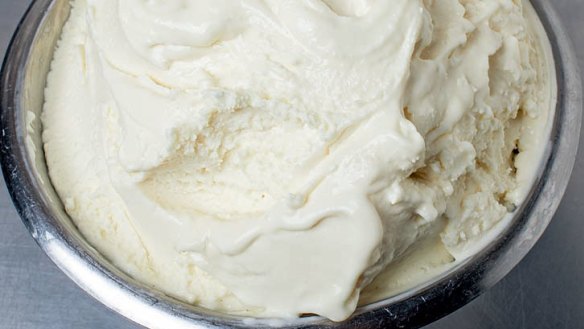Gelato recipe from Gelato Messina
Gelato Messina: The Recipes, by Nick Palumbo, Hardie Grant Books, $39.95.

Fior di Latte is the most pure of gelato flavours. It literally translates as ‘flower of milk’ but really means the ‘best part of the milk’. This gelato flavour is what we call a ‘naked’ flavour. There is nowhere to hide with this recipe, because no other flavours are used, no vanilla, no eggs, nothing … the milk and cream are the flavour. Think of it as the foundation for all your other recipes, so it’s important to get this one right both in taste and structure.
I recommend Jersey cow milk for this recipe because it has a higher fat content than normal milk (about 4% rather than 3.5%), which gives the milk a certain fragrance. It’s usually sold by farmers that take extra care of their cows and milking process, resulting in a superior milk and therefore a superior gelato.
Buffalo milk is also great; it has a high fat and protein content, so if you use this milk you need to replace the cream with more buffalo milk and subtract about 10 g (1⁄3 oz) off the amount of skim milk powder, to keep the recipe balanced. Gelato made with buffalo milk also looks amazing because it is a lot whiter than cow’s milk.
Fior di latte gelato
Milk (650g)
Cream (120g)
Sugar (145g)
Skim milk powder (45g)
Dextrose (35g)
Stabiliser (5g)
Makes 1KG
DOMESTIC
Put the milk and cream in a double boiler over a medium heat. Put all the powders in a bowl and mix until combined. When the milk and cream hit 40°C (104°F), whisk in the powders and bring the mixture up to 65°C (149°F). Keep the mixture at 65°C (149°F) for 30 minutes, whisking every 5 minutes.
Transfer the mixture to a stainless steel bowl and place in an ice bath; chill to 40°C (104°F). Cover tightly with foil and put in the freezer, stirring every 10 minutes or so until the mixture drops to 4°C (39°F), then
place in the fridge and let it age for 4 hours.
PROFESSIONAL
Put the milk and cream in a pasteuriser and select high pasteurisation. Put all the powders in a bowl and dry mix.
When the milk and cream hit 40°C (104°F), whisk in the powders; the pasteuriser will take the mixture to 85°C (185°F), then will switch to cooling phase. Once the pasteuriser runs its cycle and gets down to 4°C (39°F), let the mixture age for 4 hours at 4°C (39°F).
CHURNING
DOMESTIC
Turn on your gelato maker so it begins the freezing process.Using a stick blender, blend the mixture for
1 minute, then pour into the gelato maker. Once the mixture reaches –4°C (25°F), scoop out the gelato and transfer to a pre-cooled stainless steel bowl, cover tightly and immediately place in the freezer.
PROFESSIONAL
Measure an appropriate amount of mixture into a measuring jug and put in a batch freezer. Within 10 to 12 minutes, your mixture should be ready for extraction. For long-term storage, up to 2 weeks: Put the gelato in a blast freezer for 30 minutes, then store at –18°C (0°F). For short-term storage, 2 to 3 days: Put the gelato in a storage freezer at –18°C (0°F).

SERVING
DOMESTIC
The gelato should be served within 2 to 3 hours after placing it in the freezer, or when it reaches –12°C (10°F). If it goes below –15°C (5°F) or is left in the freezer overnight, the texture will be compromised.
PROFESSIONAL
The serving temperature of the gelato should be around –11°C (12°F) to –13°C (9°F).
Gelato Messina: The Recipes, Nick Palumbo, Hardie Grant Books, $39.95